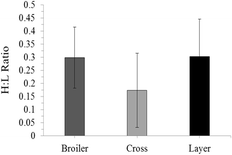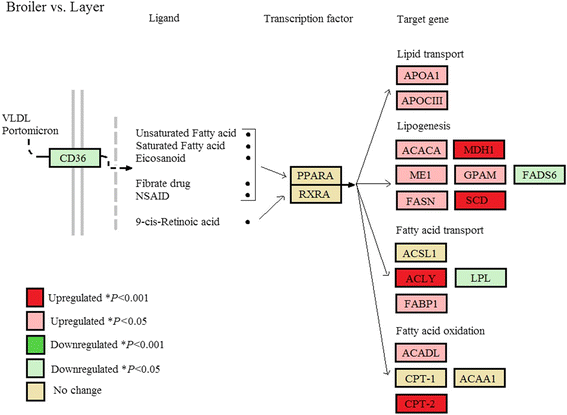Evaluation of fatty acid metabolism and innate immunity interactions between commercial broiler, F1 layer × broiler cross and commercial layer strains selected for different growth potentials
- PMID: 28883915
- PMCID: PMC5580270
- DOI: 10.1186/s40104-017-0202-4
Evaluation of fatty acid metabolism and innate immunity interactions between commercial broiler, F1 layer × broiler cross and commercial layer strains selected for different growth potentials
Abstract
Background: The broiler industry has undergone intense genetic selection over the past 50 yr. resulting in improvements for growth and feed efficiency, however, significant variation remains for performance and growth traits. Production improvements have been coupled with unfavourable metabolic consequences, including immunological trade-offs for growth, and excess fat deposition. To determine whether interactions between fatty acid (FA) metabolism and innate immunity may be associated with performance variations commonly seen within commercial broiler flocks, total carcass lipid %, carcass and blood FA composition, as well as genes involved with FA metabolism, immunity and cellular stress were investigated in male birds of a broiler strain, layer strain and F1 layer × broiler cross at d 14 post hatch. Heterophil: lymphocyte ratios, relative organ weights and bodyweight data were also compared.
Results: Broiler bodyweight (n = 12) was four times that of layers (n = 12) by d 14 and had significantly higher carcass fat percentage compared to the cross (n = 6; P = 0.002) and layers (P = 0.017) which were not significantly different from each other (P = 0.523). The carcass and whole blood FA analysis revealed differences in the FA composition between the three groups indicating altered FA metabolism, despite all being raised on the same diet. Genes associated with FA synthesis and β-oxidation were upregulated in the broilers compared to the layers indicating a net overall increase in FA metabolism, which may be driven by the larger relative liver size as a percentage of bodyweight in the broilers. Genes involved in innate immunity such as TLR2 and TLR4, as well as organelle stress indicators ERN1 and XBP1 were found to be non-significant, with the exception of high expression levels of XBP1 in layers compared to the cross and broilers. Additionally there was no difference in heterophil: lymphocytes between any of the birds.
Conclusions: The results provide evidence that genetic selection may be associated with altered metabolic processes between broilers, layers and their F1 cross. Whilst there is no evidence of interactions between FA metabolism, innate immunity or cellular stress, further investigations at later time points as growth and fat deposition increase would provide useful information as to the effects of divergent selection on key metabolic and immunological processes.
Keywords: Broiler; Cellular stress; Fatty acid metabolism; Innate immunity; Layer; Selection.
Conflict of interest statement
Ethics approval
The experimental protocol used in this study, including animal management, housing, and slaughter procedures were by the University of Adelaide Animal Ethics Committee (approval #S-2015-171) and the PIRSA Animal Ethics committee (approval #24/15).
Consent for publication
Not applicable.
Competing interests
The authors declare they have no competing interests.
Figures




Similar articles
-
The effects of Lippia javanica dietary inclusion on growth performance, carcass characteristics and fatty acid profiles of broiler chickens.Anim Nutr. 2016 Sep;2(3):160-167. doi: 10.1016/j.aninu.2016.05.003. Epub 2016 May 27. Anim Nutr. 2016. PMID: 29767096 Free PMC article.
-
Transcriptional analysis of liver from chickens with fast (meat bird), moderate (F1 layer x meat bird cross) and low (layer bird) growth potential.BMC Genomics. 2018 May 2;19(1):309. doi: 10.1186/s12864-018-4723-9. BMC Genomics. 2018. PMID: 29716547 Free PMC article.
-
Early feed restriction of broilers: effects on abdominal fat pad, liver, and gizzard weights, fat deposition, and carcass composition.Poult Sci. 1993 Feb;72(2):243-50. doi: 10.3382/ps.0720243. Poult Sci. 1993. PMID: 8441728
-
Consequences of different growth rates in broiler breeder and layer hens on embryogenesis, metabolism and metabolic rate: A review.Poult Sci. 2015 Apr;94(4):728-33. doi: 10.3382/ps/pev015. Epub 2015 Feb 17. Poult Sci. 2015. PMID: 25691756 Review.
-
Radical Response: Effects of Heat Stress-Induced Oxidative Stress on Lipid Metabolism in the Avian Liver.Antioxidants (Basel). 2020 Dec 30;10(1):35. doi: 10.3390/antiox10010035. Antioxidants (Basel). 2020. PMID: 33396952 Free PMC article. Review.
Cited by
-
Distinct cell proliferation, myogenic differentiation, and gene expression in skeletal muscle myoblasts of layer and broiler chickens.Sci Rep. 2019 Nov 11;9(1):16527. doi: 10.1038/s41598-019-52946-4. Sci Rep. 2019. PMID: 31712718 Free PMC article.
-
Identification of candidate genomic regions for chicken egg number traits based on genome-wide association study.BMC Genomics. 2021 Aug 10;22(1):610. doi: 10.1186/s12864-021-07755-3. BMC Genomics. 2021. PMID: 34376144 Free PMC article.
-
Differential Modulation of 25-hydroxycholecalciferol on Innate Immunity of Broiler Breeder Hens.Animals (Basel). 2021 Jun 10;11(6):1742. doi: 10.3390/ani11061742. Animals (Basel). 2021. PMID: 34200930 Free PMC article.
-
Distribution, Metabolism, and Recovery of Resin Acids in the Intestine and Tissues of Broiler Chickens in a Feeding Trial With Tall Oil Fatty Acid-Supplemented Diets.Front Vet Sci. 2020 Jul 28;7:437. doi: 10.3389/fvets.2020.00437. eCollection 2020. Front Vet Sci. 2020. PMID: 32851020 Free PMC article.
-
A Genome-Wide Association Study on Feed Efficiency Related Traits in Landrace Pigs.Front Genet. 2020 Jul 3;11:692. doi: 10.3389/fgene.2020.00692. eCollection 2020. Front Genet. 2020. PMID: 32719719 Free PMC article.
References
LinkOut - more resources
Full Text Sources
Other Literature Sources
Miscellaneous

